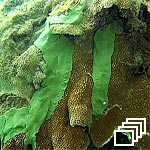Coral Disease Study at Anini Bay
Here are some pics of several corals that were treated by Dr. Greta Aeby at Anini Beach on 10-1-12. We treated 16 corals that all had the fast growing white coral disease that is caused by a new strain of cyanobacteria. The study was also conducted by Theirry Work from the USGS infectious disease department and their grad student Amanda from the University of Hawaii. I originally discovered this disease about one year ago and have been tracking its growth on thousands of corals along the north shore of Kauai.
Greta and Amanda placed a marine epoxy layer on each infected coral to see if this barrier helped stop or slow down the spreading of the disease. Half of the corals were used as "controls" which means to measure how fast the disease spreads without the treatment.
On the control corals (example number 9) the disease spread about 8 inches in just 26 days! This is extremely fast for a bacteria to kill a coral that takes 20 years for the coral to grow!! Thousands of corals have completely died out at Anini from this disease in just the last 6 months! Coral number 4 and 8 which had the epoxy barrier applied had great results! The disease was almost 100% stopped! This is the first time anything like this has been done in Hawaii so it is a big deal! On the other hand Coral number 1 had the disease break through the barrier but it did not grow as fast and the control corals that did not have the epoxy barrier.
Results of the test so far:
In the last 26 days the cyanobacteria ate the rice corals that were not treated at a rate from 7 to 10 inches! I have my white ruler in the pictures marked in cm. Greta will be doing much more detailed analysis than I have and will have a full report in the future. The corals that were treated with the epoxy barrier all had a reduced rate of growth of the bacteria. Several had no growth at all and some had from 1 to 4 inches of growth.
What does this all mean to science and the health of the reef? Greta and Thierry are doing extensive lab test on this infectious bacteria at UH as they took samples of the infected coral from Anini Beach and Tunnels Reef. They are hoping to find a cure of the infections. If they find a cure then they could place the product in the marine epoxy and apply it to the infected corals. Since the epoxy all by itself slowed down the rate of growth of the disease, this would give more time for a potential cure to work. Much like a fire break dug in front of a fast moving wild fire.
My job on the other hand is to find out what is causing the reefs all along the north shore of Kauai to be so stresses that this disease can spread so rapidly. I hope to be doing more sea water testing and acoustic testing on the reefs to find out if the reefs are dying due to chemicals in the water or vibrational energy. I am also tracking the growth of the disease with HD video all along the north shore so we can follow the spreading and see if other creatures like the sea turtles are infected with the same bacteria. I am also collecting fish species that look like they may also be infected with this bacteria and will be sending them to Theirry Work for toxicology and bacterial testing.
This is a very big problem on our reefs here in Kauai and we could use some funding and help to study, track and hopefully cure this bacterial nigh mare! I will continue to have updated pictures, video and information about this disease on my web at www.underwater2web.com . So far none of the government officials, non profits or agencies on Kauai seem to be the least bit interested in funding or helping out with this study!! You may want to contact them and ask them why.
Aloha,
Terry Lilley
Marine Biologist
Hanalei HI

Hello, 25 years go when i was keeping marine aquariums here in seattle, there was a terrible outbreak throughout the local fish stores of a superbug version that looked like ick but it was something else more virulent. White bump lesions. lysis left behind. killed everything it touched. your pictures reminded me of this. There was a UW zoologist Mark that owned “fin&feather” store and he recommended a product called greenX. It was the only treatment that worked. I cant find the product now but it was a dark green liquid that cleared up the whole tank. not sure if it was a copper/malachite in a base that was thicker than the copper solutions i make for myself now. hope this information is helpful
Is there any relationship to this infection and the use of GMO seeds on Kauai?
you bring up an interesting proposition… we need to gather and analyze a lot of data before we can come to any conclusions. More than likely, a combination of factors is stressing the reef systems, allowing the bacteria to flourish.